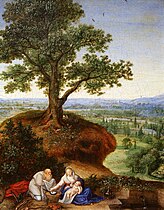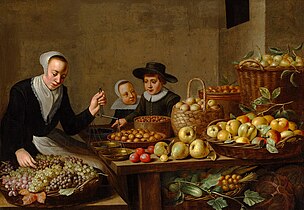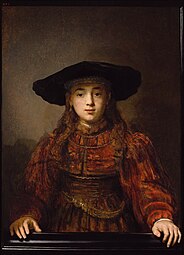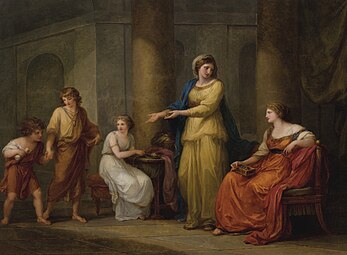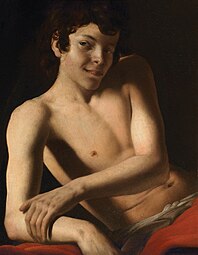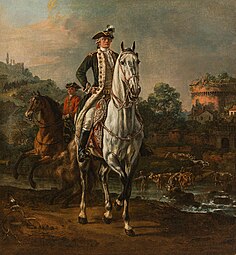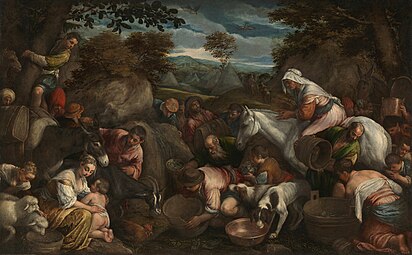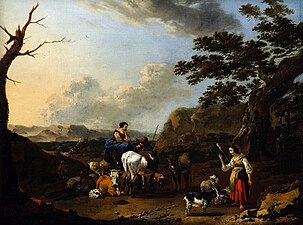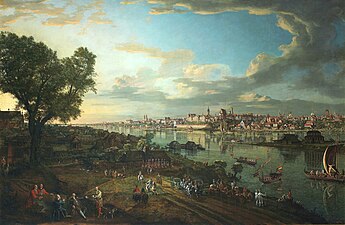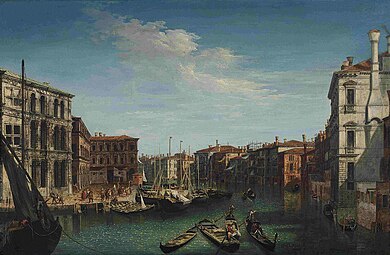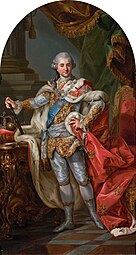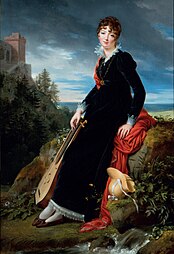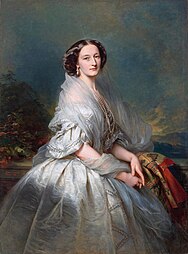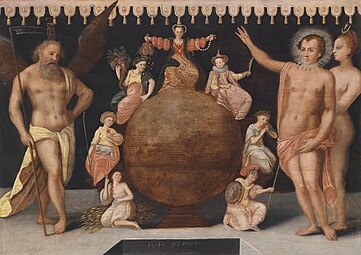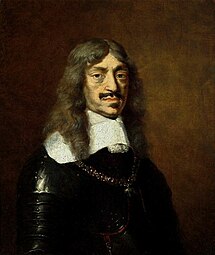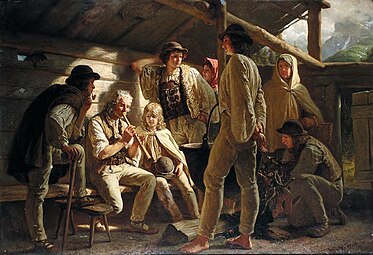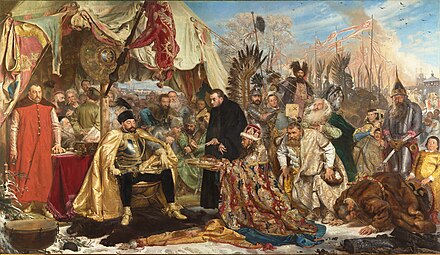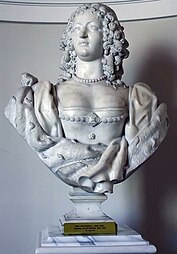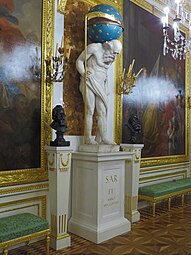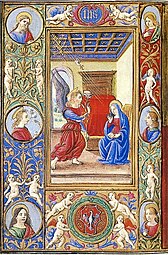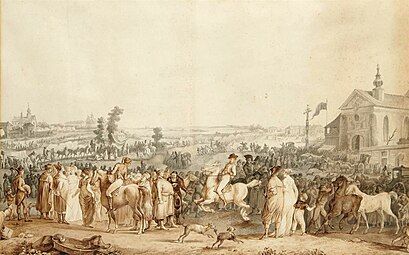User:ADTkocz/Royal Collection at the Royal Castle Warsaw
Zamek Królewski w Warszawie – Muzeum | |
 The Royal Castle on Castle Square, Warsaw | |
 Interactive fullscreen map | |
Former name | Royal Castle in Warsaw – Monument of History and National Culture (pl: Zamek Królewski w Warszawie – Pomnik Historii i Kultury Narodowej) (until 2014) |
|---|---|
| Established | 1979 |
| Location | plac Zamkowy 4, 00-277 Warszawa, Poland |
| Coordinates | 52°14′52″N 21°00′51″E / 52.24778°N 21.01417°E |
| Key holdings | Marcello Bacciarelli, Bernardo Bellotto, André-Jean Lebrun, Jan Matejko, Rembrandt van Rijn |
| Collections | Old Masters
Department of Prints and Drawings Decorative Arts Militaria Numismatic Cabinet Archaeological Collection |
| Visitors | 1,755,267 (2022)[1] |
| Director | Wojciech Fałkowski |
| Owner | state-owned |
| Website | Official Website |
The art collection of the Royal Castle in Warsaw is a collection of artworks, decorative arts as well as historical weaponry owned and exhibited in the Royal Castle Museum (Polish: Zamek Królewski w Warszawie – Muzeum) in Warsaw, Poland. The collection consists of over 800 European paintings, over 3,000 objects in the department of prints an drawings, a numismatic cabinet consisting of more than 15,000 objects, as well as a collection of archaeological artefacts acquired as part of research carried out by the research team of the Royal Castle in Warsaw between 1993 and 2014.[2]
Early History[edit]
The Former Royal Collection of Stanisław August Poniatowski[edit]
The royal collection of the last Polish monarch Stanisław August Poniatowski comprised 2,478 works, most of which were displayed at the Royal Castle in Warsaw and his summer residence the Palace on the Isle. Nowadays the Royal Łazienki Museum in the Palace on the Isle houses 137 of those paintings, additional although smaller collections can be found in the National Museum and Royal Castle in Warsaw.[3] Apart from the artworks spread across museums within Poland and abroad, the fate of nearly 2,000 works sold to public and private collections between 1814 and 1821 when Maria Teresa Tyszkiewicz inheritated the artworks after Józef Poniatowski's death.[4] Shortly after the museum's opening in 1979 around 100 works associated with the former royal collections returned between 1980–84, most of which were stored in the National Museum after they left the castle during World War II to save them from the systematic destruction of Warsaw. This group of artworks included three sets of paintings commissioned by Stanisław August for the palace: 10 portraits of famous Poles and 6 history paintings for the Knights' Hall with an additional 22 paintings of Polish rulers for the Marble Room including a monumental portrait of the ruler himself, all by Marcello Bacciarelli, and 22 canvases by Bernardo Bellotto.[2] Notably the two mythological marble statues of Saturn Chronos by Giacomo Monaldi and the personification of Eternal Glory (Fama) by André-Jean Lebrun returned to the Knights' Hall as well. All of these objects were implemented into the newly rebuild interiors according to their original plans and thus can be seen in the historic rooms on the first floor of the castle.[5]
Similar to Stanisław August's collection, the whereabouts of many objects from earlier Polish royal collections are unknown to this day. A painting commissioned in 1626 by then Prince Władysław IV Vasa documents part of the prince's art collection. None of the artworks seen on the painting are currently in the collection of the Royal Castle Museum. Namely the central painting depicting The March of Silenus by Peter Paul Rubens was looted by Frederick William, Elector of Brandenburg and displayed in the Gemäldegalerie in Berlin until it was lost and most likely destroyed in 1944 during World War II.[6]
-
Étienne de La Hire, Art Collection of Prince Władysław Vasa
-
The Canaletto Room shows the paintings by Bernardo Bellotto in a historic 18th century gallery setting.
-
Bernardo Bellotto, The Election of Stanisław August
Early Start of the Museum's own Collection[edit]
After the decision was made to rebuild the royal castle in 1971, a team of curators began to source suitable artworks for the collection. The first donations to the collection were already made in the time between the announcement of the planned museum and its opening 8 years later. In the meantime, the museum started purchasing objects on the art market.[2] However, by the time of the museum's opening in 1979, much of the exhibition still consisted of deposits by the National Museum of Warsaw.[7] The base of the just newly established collection comprised of the permanently reinstalled paintings and artworks commissioned for the interiors of the royal palace which were bequeathed to the museum for the reconstruction of the palace. Additionally, in the mid 1990s the National Museum of Warsaw donated a selection of paintings which previously belonged to the state collection of the Second Polish Republic and were exhibited at the Royal Castle during the interwar period.[2]
-
Lucas Cranach the Elder, Adam and Eve, bequeathed to the Royal Castle Museum by the National Museum Warsaw.
-
Lucas van Valckenborch, The Rest on The Flight into Egypt
-
Floris van Schooten, Fruit stall
-
Pieter van Lint, St. Mary Magdalene Penitent
Notable Donations and Foundations[edit]
Lanckoroński Collection[edit]
On 26 October 1994, Karolina Lanckorońska donated a sizeable part of the Lanckoroński collection to the Republic of Poland. Previously, parts of the collection were sold to fund Polish institutions like the Polish Library in Paris during times of hardship and can be found in museums like the National Gallery, London[8] or the Rijksmuseum, Amsterdam.[9] The beginnings of the family's collection can be traced back to a purchase made by Lanckorońska's ancestor Kazimierz Rzewuski in Warsaw in 1815, through which he obtained paintings from the royal Polish collections from Maria Teresa Tyszkiewicz, the sister and heiress of Prince Józef Poniatowski.[10] The donation was split between the Polish royal residence in Warsaw and the Wawel Royal Castle National Art Collection in Kraków. Thus, 15 more paintings from the original royal collection of King Stanisław August Poniatowski returned back to Warsaw, together with an additional collection of family portraits of the Lanckorońskis and Rzewuskis, while 76 Italian paintings enriched the art collection in Kraków.[11][10] Among these paintings, which were famously shown in the Palais Lanckoroński at the beginning of the 20th century,[11] are some of the most well known exhibits of the Royal Castle Museum in Warsaw such as the two works by Rembrandt van Rijn.[12] Authorship over these two paintings was confirmed by the Rembrandt Research Project in 2006, before they were exhibited at Het Rembrandthuis and the Gemäldegalerie during an exhibition commemorating the painter's 400th birthday.[13]
-
Rembrandt van Rijn, The Girl in a Picture Frame
-
Rembrandt van Rijn, The Scholar at the Lectern
-
Corneille de Lyon, Portrait of Antoine de Bourbon
-
Adriaen van Ostade, Two men smoking and drinking
The Ciechanowiecki Foundation[edit]
Established on 8 October 1986 by Andrzej Ciechanowiecki, the foundation collects and manages a sizeable collection of over 4,000 objects[14] including paintings, drawings and watercolours, sculptures, silverware and bronzes, porcelain, faience and glass wares, furniture, textiles, engravings, miniatures, pastels, a collection of coins, medals and gemstones, as well as a library and archive.[15] Aside from its continues donations to the Royal Castle in Warsaw,[16] the Foundation also supports other Polish and European museums through long-term loans.[17] The foundation, as Ciechanowiecki's earlier private collection, focuses on objects related to the historical collections of the castle and the cultural heritage of his homeland.[14] In May 2022 the foundation gifted 278 of its drawings and 5.164 volumes and items from Andrzej Ciechanowieck's library and collection of archival material to the museum's permanent collection.[18]
The Teresa Sahakian Foundation[edit]
The collection of the Teresa Sahakian Foundation comprises 747 works of art, mostly tapestry, and 35 additional objects predominantly used for research, conservation and maintenance. It was established on 4 February 1993 by Teresa Sahakian (née Schmidt) as a place to maintain and organise the exhibition of oriental carpets. The exhibits are not part of the collection of the Royal Castle Museum which only takes care of the safety and storage of the collection and displays select exhibits in the Copper-Roof Palace.[19]
New Ambitions since the 2010s[edit]
New Art Gallery[edit]
On 4 November 2011 the Royal Castle Museum opened their newly renovated art gallery in the former courtiers’ lodgings of the building. The newly arranged rooms opened the possibility to showcase all of the paintings from the Lanckoroński collection in one designated permanent exhibition. It marks the first major renovation of the museum's exhibition space since its opening in the 1970s. Some of the exhibition space was deemed unfit for the now enlarged collection of the museum and not on par with the high standards of the reconstructed representational rooms on the upper floor. At the opening, the permanent exhibition in the new gallery consisted of the 35 paintings donated by Karolina Lanckorońska and 55 additional paintings from the 16th and 17th centuries among approximately 200 pieces of decorative arts, furniture and sculpture.[7]
Expanded Collection and Record Numbers[edit]
The newly arranged space and renovated interiors made it possible for the museum to organise bigger exhibitions and broaden the range of artworks presented in the castle. The current museum's director Fałkowski stated in 2020 that the Royal Castle Museum has the aim to broaden its appeal by branching out from the sole focus on the reign of Stanisław August Poniatowski and the end of the Polish-Lithuanian Commonwealth.[20] Since then the museum pursues two main objectives: one focusing on the castle's history and polonica, to further complete the collection and interiors of an authentic Polish royal palace, and an additional, new stronger focus on establishing an internationally significant collection of works by European artist. This resulted in expanding the museum's collection with additions such as Italian Caravaggisti, early renaissance masters[21] and further works by renowned european artists, enabling the museum to strengthen its collaborate with leading European art galleries and the world's best museums for research projects and future exhibitions.[22] Since then, the museum has enjoyed a record increase in visitors in recent years.[20][23] Recently, the museum started hosting periodical exhibitions entitled 'Creme de la Creme' showcasing their new acquisitions.[24][25]
-
Angelica Kauffmann, Cornelia, Mother of the Gracchi, commissioned by Prince Stanisław Poniatowski in 1788 and aquired by the museum in 2021.
-
Defendente Ferrari, Madonna lactans
-
Battistello Caracciolo, Study of a young man half-length; St. John the Baptist or Bacchus
-
Bernardo Bellotto, Equestrian Portrait of the King of Poland's Page Gintowt
-
Mattia Preti, Game of Backgammon
-
Jacopo Bassano, The Israelites gathering Water from the Rock
Notable works (selection)[edit]
Paintings from Stanisław August Poniatowski's Royal Collection[edit]
The Royal Castle Museum recovered many works which were commissioned by Stanisław August Poniatowski for the interior of the palace for its opening in 1979. Also worth mentioning are the 15 works from the Lanckorinski collection, which were bequeathed to the museum in 1994.[10] Since then, the museum keeps tracing the art market and conducting research to further complete the former royal art collection. Recent examples for such additions are Melchior d'Hondecoeter's Hen, rooster and chickens (acquired in 2020)[26] and Bernardo Bellotto's Equestrian Portrait of the King of Poland's Page Gintowt (acquired in 2022)[27].
-
Ludolf Bakhuizen, A Storm in the Sea (1702)
-
Marcello Bacciarelli, Allegory of Faith
-
Philips Wouwerman, Landscape with grey horse and dismounted rider (circa 1647)
-
Melchior d'Hondecoeter, Hen, rooster and chickens
-
Jan Frans Soolmaker, Southern mountainous landscape with shepherds, their flock and a woman spinning
-
David Teniers the Younger, Traveling Doctor
-
Bernardo Bellotto, View of Warsaw from Praga with Self-Portrait
European Painting[edit]
The Museum owns a notable collection of European paintings which were not part of the former royal collection or the donations by Polish aristocracy. The collection mostly consists of Italian, Flemish, Dutch and German painting from the 14th – 18th century. Many of the recent additions by notable European painters aim to elevate the museum's collection on international scale.[22]
-
Giovanni Battista Bertucci, Julius Caesar receiving the head of Pompey
-
Abraham van Beijeren, Still Life with Silver Jug
-
Rossello di Jacopo Franchi, Madonna and Child adored by Angels
-
Cornelis Norbertus Gijsbrechts, Trompe l'oeil with violin, painter's implements and self-portrait
-
Michele Marieschi, Canal Grande with Palazzo dei Camerlenghi and Campo Erberia
Portrait Painting[edit]
The museum is in possession of a sizeable portrait gallery consisting of paintings and busts mostly depicting Polish and European aristocracy. Besides the portraits of former Polish monarchs by Marcello Bacciarelli explicitly commissions by Stanisław August Poniatowski for the Royal Castle in Warsaw, the gallery also contains paintings by noteworthy European portraitists such as Élisabeth Vigée Le Brun, Peter Lely, François Gérard, Louis de Silvestre, Franz Xaver Winterhalter, Jean-Baptiste van Loo, Thomas Gainsborough and many more.
-
Élisabeth Louise Vigée Le Brun, Portrait of Pélagie Sapieżyna née Potocka
-
Anton von Maron, The Brothers Franciszek and Kazimierz Rzewuski with Colosseum in the Background
-
Marcello Bacciarelli, Stanisław August Poniatowski in coronation robes
-
François Gérard, Portrait of countess Katarzyna Joanna Gabrielle Starzenska
-
Franz Xaver Winterhalter, Portrait of Eliza Franciszka Krasińska née Branicka
-
Thomas Gainsborough, Portrait of George III of the United Kingdom in parliamentary robes
Polish Painting[edit]
Apart from artworks by painters working at the royal court of Poland such as Daniel Schultz and Herman Han, the Royal Caslte Museum also holds a large collection of 19th century Polish painting. Multiple monumental history paintings from the series History of Civilization in Poland are exhibited in rooms designated to the Polish painter Jan Matejko.[28]
-
Herman Hahn, Allegory of diligence
-
Daniel Schultz, Portrait of John II Casimir Vasa
-
Wojciech Gerson, The shepherd's concert
-
Jan Matejko, Constitution of 3 May 1791
-
Jan Matejko, Sermon of Piotr Skarga
-
Jan Matejko, Stephen Báthory at Pskov
-
Jan Matejko, Rejtan, or the Fall of Poland
Sculpture[edit]
Many of the historic rooms of the Royal Castle Museum are adorned by works commissioned by Stanisław August Poniatowski for the interior of the residence. Apart from works by artists working at the royal court such as André-Jean Lebrun and Giacomo Monaldi, the museum also holds works by François Dieussart, Prospero Spani and Gilles Guérin among others.
-
André-Jean Lebrun, Apollo
-
Roman Bust of an Unknown Woman from the Pamphili family, circa 1650
-
Gilles Guérin, Bust of Anne of Austria, Queen of France.
-
Giacomo Monaldi, Saturn Chronos
Prints and Drawings[edit]
With over 3,000 objects, the department for prints and drawings holds the second largest collection of items in the Royal Castle Museum, most of which are stored in the archives of the museum. Select exhibits are shown in the changing permanent galleries or special temporary exhibitions. The collection consists of more than 530 drawings of which more than 280 were bequeathed to the museum by the Ciechanowiecki Foundation. Wanda Wolska-Conus accounts for another generous donation of nearly 100 drawings by old European masters which were once part of a Parisian private collection.[2] The Royal Castle Museum holds the so called Stockholm Roll depicting the wedding procession of King Sigismund III Vasa in Kraków in 1605. It was donated to the museum by the Swedish Government in 1974 after it was robbed during the Swedish deluge into Poland in the 17th century.[29] The prayer book from Polish Queen Bona Sforza was gifted to the Royal Castle in 1933 and returned to its collection in 1984.[2]
-
A leaf from Queen Bona's Prayer Book
-
Jean-Pierre Norblin de La Gourdaine, Horse Market
-
Marcello Bacciarelli, Study of Stanisław August Poniatowski in Coronation Robes
Notable Temporary Exhibitions[edit]
- "Bernardo Bellotto. On the 300th Anniversary of the Painter's Birth" 23 September 2022 – 10 January 2023[30][31]
- "Botticelli Tells a Story. Paintings by the Great Masters of the Renaissance from the collections of the Accademia Carrara" 21 June 2022 – 18 September 2022[32][33]
- "The Time of Caravaggio in the Collection of Robert Longhi" 10 November 2021 – 10 February 2022[34]
- "Rembrandt’s World. Artists. Burghers. Explorers" 28 June 2021 – 19 September 2021[35]
- "Captured Genius. Giovanni Battista Piranesi. Exhibition on the 300th Anniversary of His Birth" 28 September 2020 – 5 January 2021[36][37]
- "Dolabella. Venetian Painter of the House of Vasa" 11 September 2020 – 6 December 2020[38][39]
- "Modernism in Hungary. 1900–1930." 23 September 23 2017 – 7 January 2018[40]
Directors of the Royal Castle Warsaw – Museum[edit]
- 1979–1991 – Aleksander Gieysztor[41]
- 1991–2015 – Andrzej Rottermund[42]
- 2016–2017 – Przemysław Mrozowski[43]
- from 2017 – Wojciech Fałkowski[44]
References[edit]
- ^ Cheshire, Lee; da Silva, José (27 March 2023). "The 100 most popular art museums in the world—who has recovered and who is still struggling?". The Art Newspaper. Archived from the original on 28 March 2023. Retrieved 28 March 2023.
- ^ a b c d e f "O nas | Cyfrowa Kolekcja Zamku Królewskiego w Warszawie - Muzeum". kolekcja.zamek-krolewski.pl. Archived from the original on 8 June 2023. Retrieved 8 June 2023.
- ^ Zychowicz, Izabela (July 2017). "King Stanisław August Poniatowski's Collection of Paintings, or the European Enlightenment in the Palace on the Isle at the Royal Łazienki Museum". CODART. Archived from the original on 26 March 2023. Retrieved 8 June 2023.
- ^ Salomon, Xavier F. (2022). "Rembrandt's Polish Rider". In Juszczak, Dorota; Salomon, Xavier F. (eds.). The Polish Rider – The King's Rembrandt. The Royal Łazienki Museum in Warsaw. pp. 18–25.
- ^ The Original Castle. The Interior – history of the royal residence's afterwar reconstruction, Zamek Królewski w Warszawie - Muzeum, 15 March 2023, retrieved 8 June 2023
- ^ Dony, Frans (1980). "Alle tot nu toe bekende schilderijen van Rubens (Vol. 2)". catalogue nr. 429.
- ^ a b Driessen, Dennis (9 November 2011). "Royal Castle in Warsaw shows Rembrandt paintings from the Lanckoronski Collection in new display". CODART. Archived from the original on 23 March 2023. Retrieved 8 June 2023.
- ^ Winiewicz-Wola, Joanna (2022). Masterpieces from the Lanckoroński Collection. Kraków: Wawel Royal Castle National Art Collection. pp. 86–90.
- ^ Winiewicz-Wola, Joanna (2022). Masterpieces from the Lanckoroński Collection. Kraków: Wawel Royal Castle National Art Collection. pp. 78–84.
- ^ a b c "Kolekcja Lanckorońskich". zamek-krolewski.pl (in Polish). Retrieved 8 June 2023.
- ^ a b Winiewicz-Wola, Joanna (2022). Masterpieces from the Lanckoroński Collection. Kraków: Wawel Royal Castle National Art Collection. pp. 36–45.
- ^ Kossowski, Maciej Dariusz (2018). "O portretach Rembrandta z Zamku Królewskiego w Warszawie – analiza przedstawienia a zdefiniowanie tematu i określenie sportretowanych osób". Opuscula Musealia. 25. doi:10.4467/20843852.OM.17.020.9617.
- ^ "Zamek Królewski w Warszawie - Muzeum - Portrety. Rembrandt i..." www.zamek-krolewski.pl. Archived from the original on 2014-07-03.
- ^ a b "Fundacja Zbiorów im. Ciechanowieckich". arch.zamek-krolewski.pl (in Polish). Retrieved 8 June 2023.
- ^ Urzykowski, Tomasz (27 September 2021). "Królewski dar dla Zamku Królewskiego. Fundacja im. Ciechanowieckich przekazała dzieła sztuki". warszawa.wyborcza.pl (in Polish). Retrieved 11 June 2023.
- ^ Kruszyńska, Anna (24 May 2022). "Kolejne dzieła sztuki ze zbiorów Fundacji im. Ciechanowieckich przekazano do Zamku Królewskiego". dzieje.pl (in Polish). Retrieved 8 June 2023.
- ^ Ostrowski, Jan K. (2017). "Andrzej Stanisław Ciechanowiecki (28 IX 1924 – 2 XI 2015)". Rocznik Polskiej Akademii Umiejętności, 2015-2016. doi:10.11588/ARTDOK.00005142.
- ^ "Uroczystość przekazywania kolekcji Fundacji Zbiorów im. Ciechanowieckich Zamkowi Królewskiemu". www.zamek-krolewski.pl (in Polish). Archived from the original on 11 June 2023. Retrieved 6 June 2023.
- ^ Łubieńska, Krystyna. "Fundacja Teresy Sahakian i jej zbiory". arch.zamek-krolewski.pl (in Polish). Retrieved 9 June 2023.
- ^ a b Kuc, Monika (16 January 2020). "Rekordowy rok Zamku Królewskiego". Rzeczpospolita (in Polish). Retrieved 9 June 2023.
- ^ Majewski, Jerzy S. (25 January 2022). "Warszawa. Zamek Królewski, Madonna Paolo Uccella". Miasta Rytm (in Polish). Retrieved 11 June 2023.
- ^ a b Karnowski, Michał (9 April 2023). "Nasz Wywiad. Prof. Fałkowski, dyrektor Zamku Królewskiego w Warszawie: "Przywracamy misję państwową Zamku Królewskiego"". wpolityce.pl (in Polish). Archived from the original on 25 April 2023. Retrieved 11 June 2023.
- ^ Rusak, Jakub (16 January 2023). "Zamek Królewski w Warszawie chce pobić kolejny rekord. Kusi arcyciekawymi wystawami". www.well.pl (in Polish). Retrieved 9 June 2023.
- ^ Szkurłat, Anna (15 March 2023). "Wystawa Crème de la crème. Wybrane nabytki 2021-2022. Zamek Królewski w Warszawie". www.polityka.pl (in Polish). Retrieved 11 June 2023.
- ^ Montowski, Michał (16 May 2023). "Po Drugiej Stronie Lustra – Prof. Wojciech Fałkowski: Zamek Królewski pięknieje z każdym zakupem". Jedynka - Polskie Radio (in Polish). Retrieved 11 June 2023.
- ^ "Raport Roczny 2020. Zamek Królewski w Warszawie – Muzeum" (PDF). zamek-krolewski.pl. 2021. p. 10.
- ^ "Funkelnde Kostbarkeiten im Kinsky". Die Presse (in German). 31 October 2022. Retrieved 10 June 2023.
- ^ "Kolekcja sztuki Zamku Królewskiego w Warszawie". www.zamek-krolewski.pl (in Polish). Retrieved 11 June 2023.
- ^ Dowell, Stuart (5 February 2019). "Stunning 15-metre scroll hidden for hundreds of years goes on display at Royal Castle – but be quick as it will soon disappear again for another decade!". www.thefirstnews.com. Retrieved 11 June 2023.
- ^ Janiszewska-Cardone, Aleksandra (21 September 2022). "Bellotto: the 18th-century artist who helped Warsaw rise from the ashes of WWII". Notes From Poland. Retrieved 11 June 2023.
- ^ "Bernardo Bellotto. On the 300th Anniversary of the Painter's Birthday". zamek-krolewski.pl. Retrieved 11 June 2023.
- ^ Łanuszka, Magdalena (23 June 2022). ""Botticelli Tells a Story. Paintings by the Great Masters of the Renaissance from the collections of the Accademia Carrara" Exhibition at the Royal Castle in Warsaw". herito. Retrieved 11 June 2023.
- ^ Khan, Ravail (28 July 2022). "NArchitekTURA exhibits botticelli masterpiece in renaissance chamber of warsaw castle". designboom | architecture & design magazine. Retrieved 11 June 2023.
- ^ "The Time of Caravaggio in the Collection of Roberto Longhi". Civita Mostre e Musei. Retrieved 11 June 2023.
- ^ "Rembrandt's World. Artists. Burghers. Explorers". CODART. 26 July 2021. Retrieved 11 June 2023.
- ^ Bernat, Anna (28 September 2020). "„Uwięziony geniusz. Giovanni Battista Piranesi" - wystawa rycin na Zamku Królewskim". dzieje.pl (in Polish). Retrieved 11 June 2023.
- ^ "Captured Genius. Giovanni Battista Piranesi. Exhibition on the 300th Anniversary of His Birth". arch.zamek-krolewski.pl (in Polish). Retrieved 11 June 2023.
- ^ "Dolabella. Venetian Painter of the House of Vasa". arch.zamek-krolewski.pl (in Polish). Retrieved 11 June 2023.
- ^ Stanisławski, Wojciech. "Tommaso Dolabella. The Venetian paints the Sarmatians". Polish History. Retrieved 11 June 2023.
- ^ "Modernism in Hungary 1900–1930". arch.zamek-krolewski.pl (in Polish). Retrieved 11 June 2023.
- ^ Mrozowski, Przemysław (11 August 2020). "Aleksander Gieysztor, the First Director of the Royal Castle in Warsaw". Muzealnictwo. 61: 181–191. doi:10.5604/01.3001.0014.3515. ISSN 0464-1086.
- ^ "Andrzej Rottermund po 24 latach odchodzi z Zamku Królewskiego". Polsat News (in Polish). 14 December 2015. Retrieved 11 June 2023.
- ^ "Zamek Królewski w Warszawie ma nowego dyrektora". Radio UKSW (in Polish). Retrieved 2 January 2017.
- ^ Urzykowski, Tomasz (30 October 2017). "Wojciech Fałkowski, człowiek Macierewicza, nowym dyrektorem Zamku Królewskiego w Warszawie". warszawa.wyborcza.pl. Retrieved 11 June 2023.






